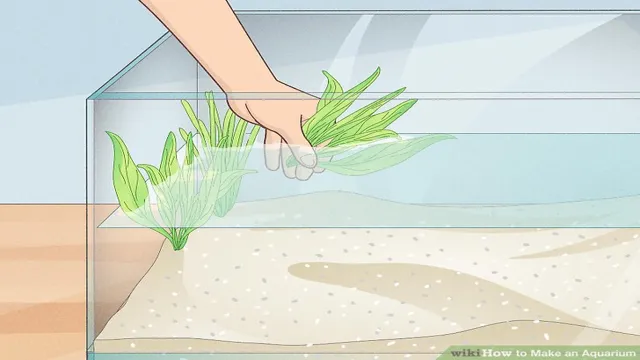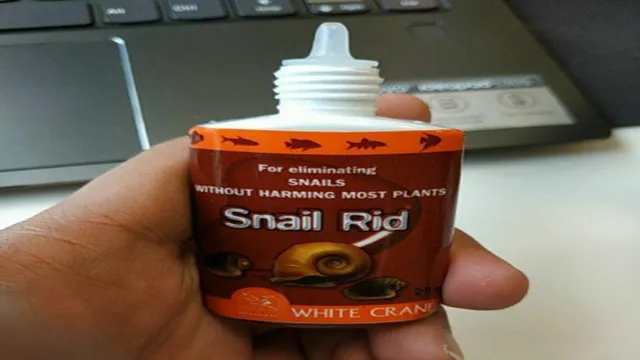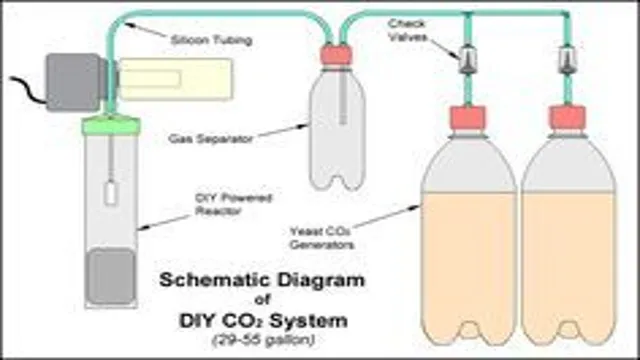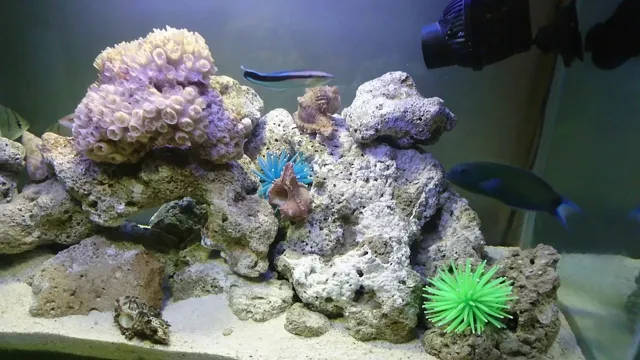How to Create CO2 for Aquarium Plants: A Beginner’s Guide to Healthy Growth

If you’re a fish enthusiast, you probably know that having an aquarium requires more than just providing fish with water and food. Aquarium plants play a vital role in keeping your fish tank healthy by replenishing oxygen, removing harmful toxins, and providing hiding spaces for fish to rest. But did you know that plants need carbon dioxide (CO2) to thrive? While plants can absorb CO2 from the air, creating CO2 specifically for your aquarium plants can improve their growth and health significantly.
In this blog, we’ll dive into the benefits of CO2 for aquarium plants and the different methods you can use to create CO2 in your aquarium setup. So, get ready to take your aquatic ecosystem to the next level!
Understanding CO2 for Aquarium Plants
If you want to create a healthy environment for your aquarium plants, you need to ensure that they are getting enough CO Luckily, there are a few ways to add CO2 to your aquarium, such as using a CO2 injection system or adding supplements. CO2 injection systems are high-tech and reliable but can be expensive.
If you’re on a budget, you may want to consider adding supplements such as liquid CO2 or carbon tablets. However, you need to be careful when using supplements since over-dosing can harm your fish and plants. To avoid any problems, start with a small amount and gradually increase the dosage.
Additionally, ensure that you provide enough light and nutrients to your plants to maximize their growth potential, and regularly monitor their health to address any issues promptly. With these simple steps, you can create an environment that promotes vibrant and healthy aquarium plants.
The Importance of CO2 for Aquarium Plants
CO2 for aquarium plants Aquarium plants are a wonderful addition to any tank, but they require plenty of attention and care. One of the most important factors to consider when it comes to these aquatic plants is CO2, or carbon dioxide. CO2 is vital for the growth and health of aquarium plants, as they use it during photosynthesis to produce their energy and life-sustaining oxygen.
Without adequate amounts of CO2, your aquarium plants will struggle to grow and may even die off. Therefore, it is crucial to monitor and regulate the CO2 levels in your aquarium to ensure a healthy environment for your plants. You can do this through various methods such as using CO2 injection systems or adding natural sources of CO2 such as fish waste or decaying plant matter.
Understanding the importance of CO2 for aquarium plants will help you keep your plants thriving and your tank looking beautiful and healthy. So, give your plants the attention they need and keep their CO2 levels in check!

Types of CO2 Injection Systems
CO2 injection systems are essential for aquarium plants to thrive and grow. There are mainly two types of CO2 injection systems: the pressurized CO2 system and the DIY yeast CO2 system. The pressurized CO2 system is a more expensive but more efficient option, where carbon dioxide is kept under high pressure and then diffused into the aquarium water through a diffuser.
On the other hand, the DIY yeast CO2 system is a cheaper option, but its efficiency is lower. It requires one to mix yeast and sugar with water, which creates carbon dioxide through fermentation. This setup can be unpredictable, and the CO2 production can vary based on the yeast’s age and other factors.
Either option you choose, it’s essential to ensure that the CO2 injection system’s output is compatible with the size of your aquarium and the plants’ requirements. Too much CO2 can harm your aquatic pets, and too little can hinder plant growth. Therefore, maintaining the right balance is necessary.
DIY CO2 Injection System
Are you looking for a budget-friendly way to provide your aquarium plants with the much-needed CO2? Well, creating your own CO2 injection system is easier than you might think. All you need are a few simple and affordable materials such as a plastic bottle, some airline tubing, a check valve, and some yeast and sugar. First, mix one cup of sugar and one quart of warm water together.
Then add half a teaspoon of yeast to the mixture, stirring gently until everything is dissolved. Pour the mixture into the plastic bottle, leaving a couple of inches of space at the top. Finally, attach the airline tubing, making sure to add the check valve to prevent water from entering the bottle.
Allow the mixture to ferment for several hours before inserting the tubing into your aquarium. The CO2 produced by the reaction between the sugar and yeast will slowly diffuse into the water, providing your plants with a continual source of CO Creating your own CO2 injection system is a fun and affordable way to enhance the growth and health of your aquarium plants without breaking the bank.
Materials Needed to Create a DIY CO2 Injection System
Creating your own DIY CO2 injection system can be a great way to enhance the growth of your plants. But to do so, there are some materials and tools you’ll need to gather. First, you’ll need a CO2 tank, which can be purchased at your local home improvement or hardware store.
Next, you’ll need a CO2 regulator, which will help you regulate the amount of CO2 that is released into your aquarium or terrarium. You will also need a bubble counter, which is used to measure the amount of CO2 being injected into your system. Additionally, you will need tubing to connect all of the components, as well as a diffuser to distribute the CO2 evenly throughout your tank.
Finally, you may want to consider investing in a pH monitor to ensure that the levels in your tank are balanced. With these materials, you should be able to create a functional and effective DIY CO2 injection system that will help your plants thrive.
Steps to Make a DIY CO2 Injection System
If you’re looking to improve plant growth in your aquarium, then a DIY CO2 injection system might be just what you need. By adding CO2 to the water, you can provide your plants with the necessary nutrient they need to thrive. To make a DIY CO2 injection system, you will need a few pieces of equipment, including a CO2 generator or yeast reactor, a pressure gauge, a check valve, and a bubble counter.
Once you have all the equipment, assembling the system is relatively straightforward. However, it’s essential to make sure you follow the instructions for each piece of equipment carefully. Failure to do so could result in leaks or even damage to your aquarium.
When setting up your CO2 injection system, it’s important to start slowly and monitor the impact on your plants. CO2 is potent, and too much can harm your fish or plants. By gradually increasing the amount of CO2 you add, you can find the right balance to achieve optimal plant growth.
So, if you’re on a budget and want to improve plant growth in your aquarium, a DIY CO2 injection system is the perfect solution!
Tips for Maintaining a DIY CO2 Injection System
Maintaining a DIY CO2 injection system can be both rewarding and challenging. To ensure that your system is functioning properly and providing your plants with the necessary CO2, there are a few tips to keep in mind. First and foremost, it is important to regularly check the system’s tubing, regulators, and diffusers for any signs of damage or leaks.
A damaged system can lead to inconsistent CO2 distribution, which can harm your plants. Additionally, it is essential to monitor the pH levels in your aquarium or planted tank to ensure that they remain within healthy ranges. Finally, make sure to regularly remove and clean the diffusion stones to prevent clogs and promote efficient diffusion of CO
With these tips in mind, maintaining a DIY CO2 injection system can be a rewarding and fulfilling experience for any aquarium or plant enthusiast.
Store-Bought CO2 Injection Systems
If you’re looking for an easy way to infuse your aquarium plants with CO2, then a store-bought CO2 injection system may be just what you need. These systems are designed to pump carbon dioxide into your aquarium water, providing your plants with the essential nutrients they need to thrive. To create CO2 for aquarium plants at home can be a little bit of a hassle, and it requires a bit of experience to get it right.
Store-bought CO2 injection systems come in various forms, ranging from affordable beginner-level systems to more sophisticated units with advanced features and adjustable settings. They are easy to install and use, making them a popular option for hobbyists who want to give their aquarium plants a boost without the extra work and maintenance of DIY CO2 setups. If you’re new to planted aquariums, a store-bought CO2 injection system might be a great investment to consider.
Types of Store-Bought CO2 Injection Systems
Store-bought CO2 injection systems are a must-have for aquarists who want to maintain the perfect pH levels in their tanks. These systems come in different types, each with its unique features and functionality. The most common types of store-bought CO2 injection systems include the diffuser, reactor, and cartridge-based systems.
Diffuser systems use a diffuser to break down the CO2 into tiny bubbles that can flow through the water column, making them perfect for small tanks. Reactor systems, on the other hand, produce more concentrated CO2 and are best for larger tanks. They work by mixing water and CO2 in a reactor chamber to produce a highly concentrated solution that is then diffused into the tank.
Cartridge-based systems are easy to install and require no technical expertise. They come pre-filled with CO2 and are designed to last for several months before needing a refill. They are also portable, making them perfect for those who want to keep their tanks healthy while traveling.
Store-bought CO2 injection systems are essential for maintaining healthy aquatic life, and aquarists need to choose the one that best suits their needs. Whether you have a small or large tank, there is a CO2 injection system out there that can help you maintain the perfect pH levels for your fish and plants.
Benefits and Drawbacks of Store-Bought CO2 Injection Systems
CO2 injection systems can be a great way to boost your plant growth, but there are pros and cons to using store-bought CO2 injection systems. On the plus side, these systems are usually easy to set up and use, and they are readily available at most gardening stores. They can provide a consistent source of CO2 for your plants, helping them to grow faster and healthier.
However, there are also some drawbacks to store-bought systems. They can be expensive, and the cost can add up over time. Additionally, some systems may not be as effective as others, depending on the type of plants you are growing and other factors.
It’s important to do your research and choose a system that will work well for your specific needs. Overall, store-bought CO2 injection systems can be a good choice if you are looking to give your plants a boost, but it’s important to be aware of the potential drawbacks before you invest in one.
Conclusion and Final Thoughts
In conclusion, creating CO2 for aquarium plants is easy as pie. Simply mix yeast, sugar and warm water in a bottle and watch the magic happen – but be prepared for some funky smells! Providing your plants with the right amount of CO2 is essential for their growth and overall health. Plus, it adds an extra touch of whimsy to your aquascape.
So go ahead and don your mad scientist hat, and let the CO2 bubbles flow!”
FAQs
What is the importance of CO2 for aquarium plants?
CO2 is essential for aquatic plants as it helps in photosynthesis and growth. Without it, plants may struggle to thrive and may even die.
What are the different ways to create CO2 for aquarium plants?
There are different approaches to create CO2 for aquarium plants, such as injecting CO2 gas, using yeast CO2 reactors, or adding liquid CO2 supplements.
How can I inject CO2 gas into my aquarium?
You can inject CO2 gas into your aquarium using a CO2 regulator and diffuser. The regulator helps control the amount of CO2 injected, while the diffuser ensures even distribution.
What is a yeast CO2 reactor, and how does it work?
A yeast CO2 reactor is a DIY setup that produces CO2 by fermenting sugar and yeast. As the mixture ferments, it releases CO2, which can be diffused into the aquarium.
Are liquid CO2 supplements an effective way to provide CO2 for aquarium plants?
Yes, liquid CO2 supplements can be effective in providing CO2 for aquarium plants, especially for low-light tanks or when injecting CO2 gas is not feasible.
How much CO2 do my aquarium plants need?
The ideal CO2 level in an aquarium for plant growth is around 30 ppm (parts per million). However, it’s important to monitor the CO2 levels and adjust them based on the plant’s needs.
Are there any risks associated with injecting CO2 into an aquarium?
Yes, if not used correctly, injecting CO2 into an aquarium can be risky. Overdosing CO2 can lead to oxygen depletion and harm aquatic life. It’s essential to follow safety guidelines and monitor CO2 levels regularly.





